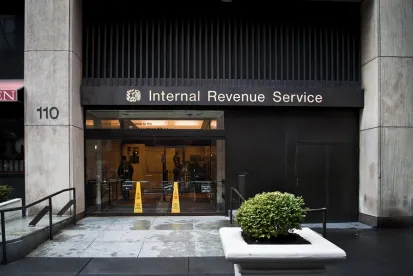On August 28, 2020, the Department of the Treasury (“Treasury”) and the Internal Revenue Service (“IRS”) released Notice 2020-65 to provide guidance (“Agency Guidance”) implementing the employee payroll tax deferral directed by the “Memorandum on Deferring Payroll Tax Obligations in Light of the Ongoing COVID-19 Disaster” (“Presidential Memo”), issued on August 8, 2020, which we previously reported on here.
While the Agency Guidance provides answers to some of the questions raised by the Presidential Memo, it still leaves unanswered the questions that are necessary for employers to implement the deferral, if they choose to take the risk.
Deferral Is Optional for Employers
The Presidential Memo directs the Secretary of Treasury to use his authority pursuant to Section 7508A of the Internal Revenue Code to delay the deadline for certain actions due to nationally declared disasters, such as the COVID-19 pandemic. However, Section 7508A does not give the President authority to require taxpayers to use the extended deadlines. As reported in Bloomberg Law: Tax, an IRS attorney confirmed on September 3, 2020, during the agency’s monthly payroll industry teleconference, that “employers may, but are not required, to utilize the relief.” This is consistent with our read of the Agency Guidance, an accompanying IRS News Release, and widely reported comments made by Treasury Secretary Steven Mnuchin.
The Agency Guidance gives employers, not employees, the controlling choice of whether to defer withholding the Social Security tax of 6.2 percent on “Applicable Wages” paid by employees during the period of September 1, 2020, through December 31, 2020 (“Deferral Period”). If an employer chooses to allow the deferral, the employer will be responsible for ratably withholding and paying the deferred payroll taxes between January 1, 2021, and April 30, 2021 (“Repayment Period”). Interest, penalties, and additions to taxes will begin to accrue on May 1, 2021. However, an employer “may make arrangements to otherwise collect the total Applicable Taxes from the employee.”
The Agency Guidance is silent as to whether employees whose earnings are below the threshold set in the Presidential Memo for eligibility may elect to opt in or out of a deferral, so it appears that this decision would be at employers’ discretion.
In addition, employers that choose to opt in face practical and administrative challenges and should work with their payroll vendors to determine if an individualized employee election approach is administratively feasible, or whether a uniform approach (e.g., requiring deferrals for all impacted employees) is more practical. An employer with a unionized workforce might have to engage in collective bargaining over whether it will defer payroll tax withholding or offer the deferrals as an option to eligible employees, as well as over other terms related to the deferrals.
Unless Congress takes action to forgive the deferrals, one of the most significant risks for an employer implementing the deferral is that the employer may be liable for deferrals that it may be unable to collect from employees who are terminated, resign, or are on leave, or have inadequate pay/reduced schedules, during the Repayment Period.
While employers may wish to mitigate that risk by entering into written repayment arrangements with employees (e.g., to take the deferrals in a final paycheck), the “ratable withholding” requirement would appear to prevent an employer from accelerating the repayment or collecting a large, one-time payment in one pay period. In addition, some states have strict rules about the purposes for which an employer can deduct from wages, including final wages. Moreover, if employers pay those taxes on behalf of terminated employees, the employees could also owe income and payroll taxes because payment of the terminated employees’ deferred payroll taxes would be considered income to the employees.
September 1 Start Date; Additional Reporting
The Agency Guidance is silent as to whether an employer must defer for the full Deferral Period. Given the timing of the guidance, just days before the four-month payroll deferral period beginning on September 1, 2020, employers are unlikely to be ready to implement the deferral. Employers that wish to opt in should have the ability to implement the deferral at any time during the Deferral Period.
It is not clear whether a retroactive adjustment period process will be permitted if payroll systems are not updated in time. Nor is it clear whether there will be an opportunity to correct any errors or delays in deferrals, for example, on a Form 941-X.
In addition, the IRS released a draft Form 941 that includes a line for “[d]eferred amount of social security tax.” However, the impact on IRS Form 941 for repayment in the first and second quarters of 2021 is not yet known. Nor is the impact of the deferral on the 2020 Form W-2 process clear.
Wages Are Determined on a Pay-Period-by-Pay-Period Basis
Employers are to determine the Applicable Wages for deferral purposes each pay period. “Applicable Wages” are “wages,” as defined in Section 3121(a) (Social Security covered wages), or “compensation,” as defined in Section 3231(e) (the comparable Railroad retirement tax covered wages), paid to an employee during the Deferral Period, subject to a threshold amount.
While the Presidential Memo used vague language, the Agency Guidance provides a specific limit for Applicable Wages. If the amount of wages or compensation to an employee for a pay period is less than the threshold amount of $4,000 paid for a biweekly period or the equivalent amount if employees are paid on a different frequency (e.g., $2,000 weekly, $8,666 monthly), then that amount is considered Applicable Wages for that pay period, regardless of the amount of wages or compensation paid to that employee in a different pay period. This means that employees whose pay fluctuates over and under the threshold during the Deferral Period will only be eligible for the deferral during the pay periods in which their pay is less than the threshold amount of $4,000.
Because Applicable Wages may include nonrecurring compensation (supplemental wages), such as overtime, bonuses, and equity awards, otherwise eligible employees receiving such compensation that pushes them over the applicable threshold in a particular pay period during the four-month Deferral Period would be ineligible for the deferral for that pay period.
Employer Options
Employers are between a rock and a hard place. Allowing the payroll tax deferral has significant practical and administrative challenges (especially if employers choose to give employees a choice of whether or not to defer) and tax consequences, unless Congress takes legislative action and forgives the deferrals. On the other hand, continuing to withhold can create employee relations issues, especially if Congress later takes legislative action to forgive the deferrals, because employees may feel that they “lost” out on a benefit because their employers denied them from having it.
Whether Congress will take action to forgive the deferrals is uncertain. One concern about forgiveness of deferrals is that it would impact Social Security funding. While the Trump administration has stated its intent to seek congressional action to forgive the deferrals and make up the shortfall funding to Social Security out of Treasury’s General Fund, it is unclear whether any future legislation would address how forgiveness of any deferral would impact Social Security credits accrued by an impacted individual.
Below are possible outcomes based on congressional action that employers should consider, in consultation with their legal and tax advisors, before making any decisions.
|
Employer Action |
Potential Outcomes if |
Potential Outcome if |
| Employer Stops Withholding |
No employer or employee tax liability Employee has access to deferrals |
Employer must ratably withhold beginning January 1, 2021 Employer remains liable for employee’s tax and subject to penalty if tax is unpaid during Repayment Period No relief for determining Applicable Wages or penalties if error is made Additional reporting and taxes to employee if employer pays employee’s tax |
| Employer Continues Withholding |
No employer or employee tax liability If legislation only forgives for those whose employers stop withholding, employee relations issues (“lost” Employees could claim a refund for overpaid Social Security taxes |
No employer or employee tax liability Potential employee relations issues (based on time value of money) |
The Agency Guidance is clear that an employer cannot continue to withhold the tax but suspend the deposit of it until next year. Therefore, a wait-and-see approach is not a viable option for employers.
To address the potential employee relations issues with not allowing the deferral and continuing to withhold, employers could consider providing a nominal, taxable “bonus” to compensate employees for the lost deferral (and potential forgiveness) opportunity. This approach would recognize the cost savings available to employers by avoiding the administrative challenges with implementing the deferral.
Modest Benefit
When weighing the options, employers should consider whether the potential increase to eligible employees’ short-term cash flow outweighs the potential greater hardship they may face in the first four months of 2021 when they must repay the deferral, assuming Congress does not forgive the deferral.
Practically, allowing the deferral is likely to result in a modest benefit to eligible employees. For employees that earn the maximum $3,999 every two weeks for nine pay periods, the benefit is $2,231 ($3,999 x 6.2% x 9 pay periods). When considering whether to allow the deferral, employers should be mindful to communicate the potential greater financial hardship employees may face in January through April of next year as a result of the repayment obligation that would occur at that time.
Lukewarm Reception by Employers
While, as reported here, the largest U.S. employer, the federal government, is moving ahead and will begin deferring federal employees’ Social Security taxes during the Deferral Period, apparently without an employee opt-out choice, it appears unlikely that many private employers will follow suit. It has been reported here and here that the U.S. Chamber of Commerce has said it does not believe that many of its members will participate in the payroll tax deferral.
What Employers Should Do Now
- Consider your options in consultation with tax and legal advisors.
- Decide whether to allow the tax deferral or continue the withholding, and if the tax deferral will be allowed:
- decide whether employee elections will be permitted and how they will be implemented,
- work with vendors to make payroll system changes,
- budget for the repayment of taxes in the event collection from employees is impossible, and
- prepare for additional reporting.
- Communicate your decision to employees.
- Determine whether to notify and confer with employees’ collective bargaining representatives.
- Monitor for additional guidance from Treasury and the IRS and other developments, such as legislation that forgives the deferral.
Jeffrey G. Kramer contributed to this article.






 />i
/>i

